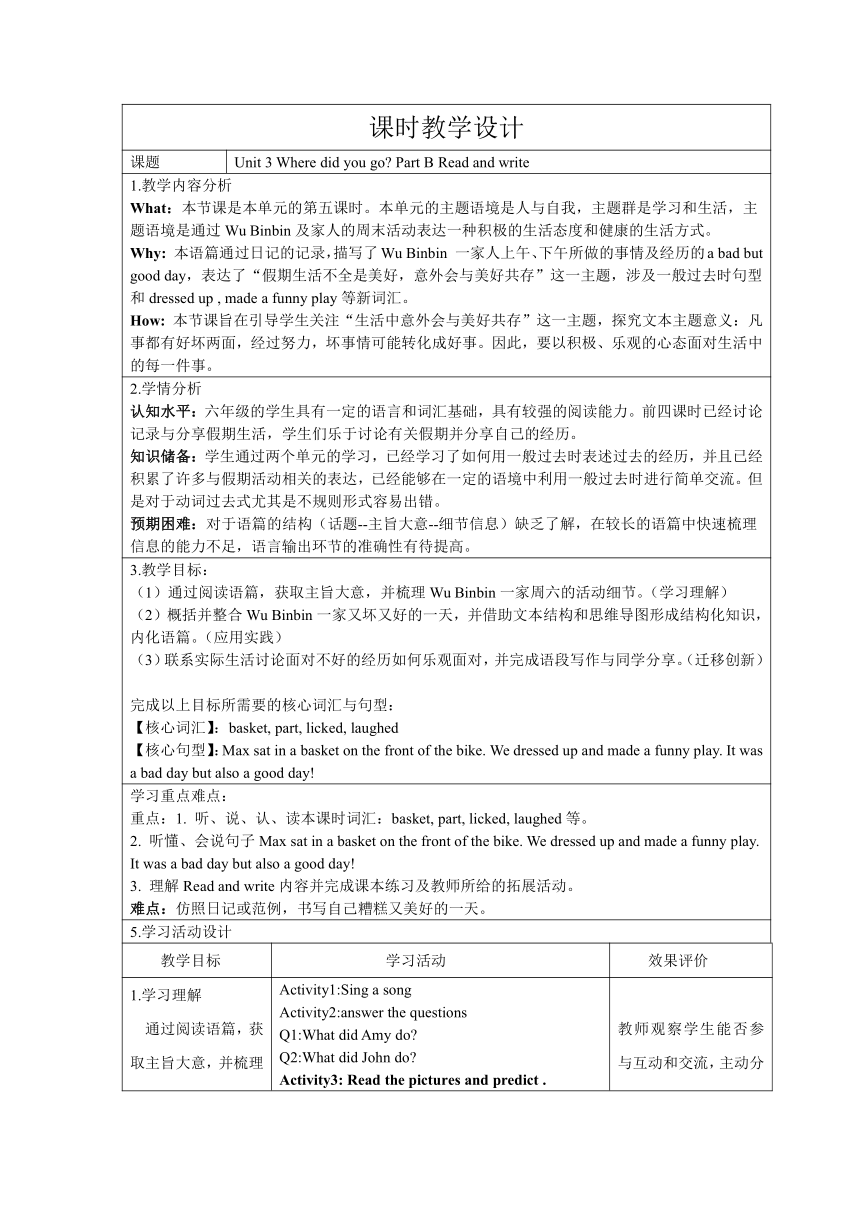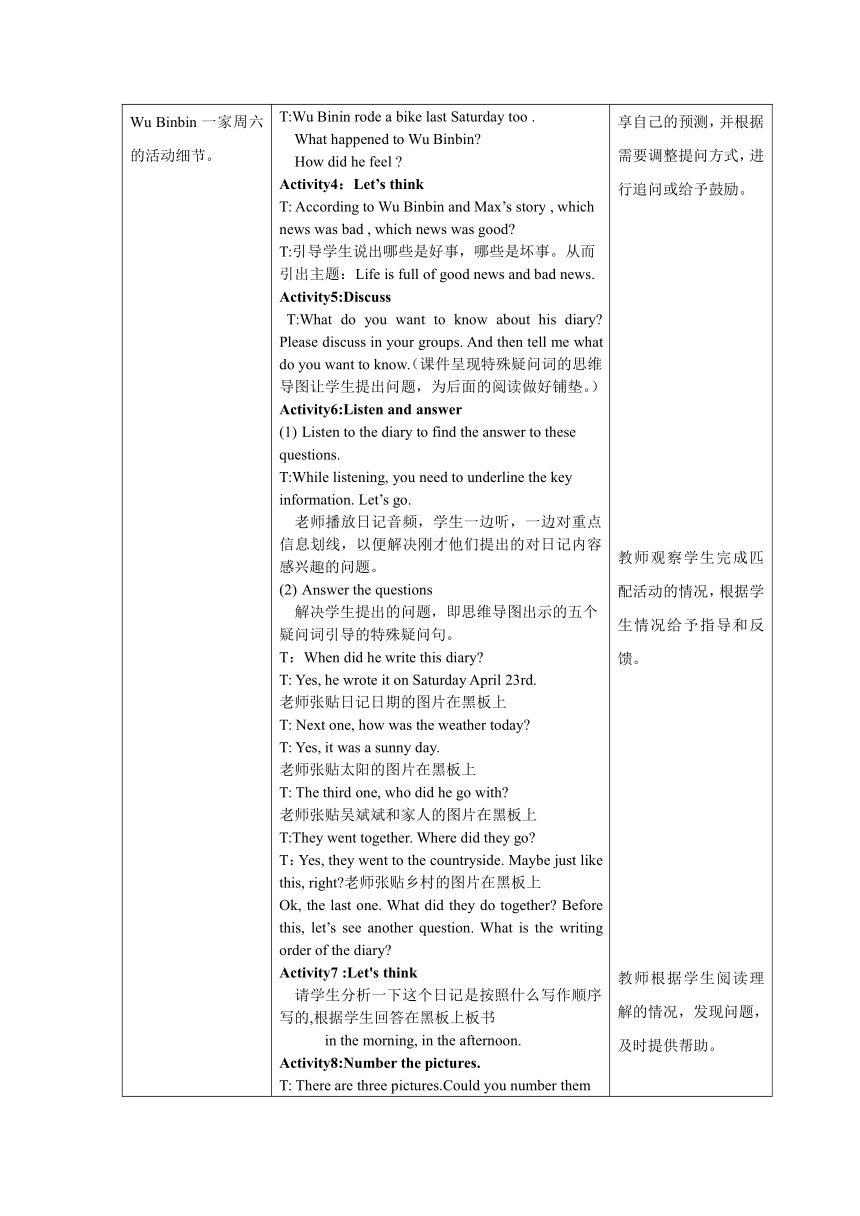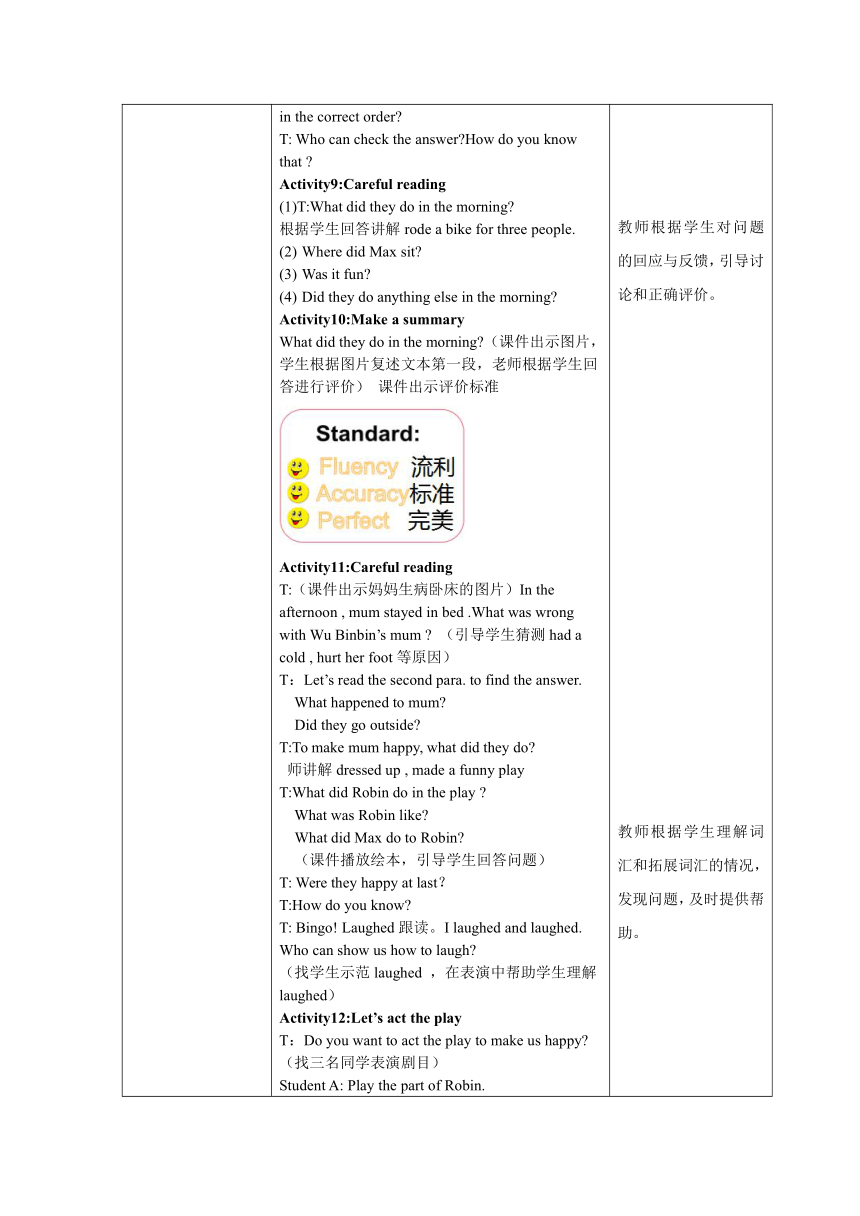Unit3 Where did you go?Part B Read and write 表格式教案
文档属性
| 名称 | Unit3 Where did you go?Part B Read and write 表格式教案 |  | |
| 格式 | docx | ||
| 文件大小 | 1.1MB | ||
| 资源类型 | 教案 | ||
| 版本资源 | 人教版(PEP) | ||
| 科目 | 英语 | ||
| 更新时间 | 2024-10-16 08:43:00 | ||
图片预览



文档简介
课时教学设计
课题 Unit 3 Where did you go Part B Read and write
1.教学内容分析 What:本节课是本单元的第五课时。本单元的主题语境是人与自我,主题群是学习和生活,主题语境是通过Wu Binbin及家人的周末活动表达一种积极的生活态度和健康的生活方式。 Why: 本语篇通过日记的记录,描写了Wu Binbin 一家人上午、下午所做的事情及经历的a bad but good day,表达了“假期生活不全是美好,意外会与美好共存”这一主题,涉及一般过去时句型和dressed up , made a funny play等新词汇。 How: 本节课旨在引导学生关注“生活中意外会与美好共存”这一主题,探究文本主题意义:凡事都有好坏两面,经过努力,坏事情可能转化成好事。因此,要以积极、乐观的心态面对生活中的每一件事。
2.学情分析 认知水平:六年级的学生具有一定的语言和词汇基础,具有较强的阅读能力。前四课时已经讨论记录与分享假期生活,学生们乐于讨论有关假期并分享自己的经历。 知识储备:学生通过两个单元的学习,已经学习了如何用一般过去时表述过去的经历,并且已经积累了许多与假期活动相关的表达,已经能够在一定的语境中利用一般过去时进行简单交流。但是对于动词过去式尤其是不规则形式容易出错。 预期困难:对于语篇的结构(话题--主旨大意--细节信息)缺乏了解,在较长的语篇中快速梳理信息的能力不足,语言输出环节的准确性有待提高。
3.教学目标: (1)通过阅读语篇,获取主旨大意,并梳理Wu Binbin一家周六的活动细节。(学习理解) (2)概括并整合Wu Binbin一家又坏又好的一天,并借助文本结构和思维导图形成结构化知识,内化语篇。(应用实践) (3)联系实际生活讨论面对不好的经历如何乐观面对,并完成语段写作与同学分享。(迁移创新) 完成以上目标所需要的核心词汇与句型: 【核心词汇】:basket, part, licked, laughed 【核心句型】:Max sat in a basket on the front of the bike. We dressed up and made a funny play. It was a bad day but also a good day!
学习重点难点: 重点:1. 听、说、认、读本课时词汇:basket, part, licked, laughed等。 2. 听懂、会说句子Max sat in a basket on the front of the bike. We dressed up and made a funny play. It was a bad day but also a good day! 3. 理解Read and write内容并完成课本练习及教师所给的拓展活动。 难点:仿照日记或范例,书写自己糟糕又美好的一天。
5.学习活动设计
教学目标 学习活动 效果评价
1.学习理解 通过阅读语篇,获取主旨大意,并梳理Wu Binbin一家周六的活动细节。 Activity1:Sing a song Activity2:answer the questions Q1:What did Amy do Q2:What did John do Activity3: Read the pictures and predict . T:Wu Binin rode a bike last Saturday too . What happened to Wu Binbin How did he feel Activity4:Let’s think T: According to Wu Binbin and Max’s story , which news was bad , which news was good T:引导学生说出哪些是好事,哪些是坏事。从而引出主题:Life is full of good news and bad news. Activity5:Discuss T:What do you want to know about his diary Please discuss in your groups. And then tell me what do you want to know.(课件呈现特殊疑问词的思维导图让学生提出问题,为后面的阅读做好铺垫。) Activity6:Listen and answer Listen to the diary to find the answer to these questions. T:While listening, you need to underline the key information. Let’s go. 老师播放日记音频,学生一边听,一边对重点信息划线,以便解决刚才他们提出的对日记内容感兴趣的问题。 Answer the questions 解决学生提出的问题,即思维导图出示的五个疑问词引导的特殊疑问句。 T:When did he write this diary T: Yes, he wrote it on Saturday April 23rd. 老师张贴日记日期的图片在黑板上 T: Next one, how was the weather today T: Yes, it was a sunny day. 老师张贴太阳的图片在黑板上 T: The third one, who did he go with 老师张贴吴斌斌和家人的图片在黑板上 T:They went together. Where did they go T:Yes, they went to the countryside. Maybe just like this, right 老师张贴乡村的图片在黑板上 Ok, the last one. What did they do together Before this, let’s see another question. What is the writing order of the diary Activity7 :Let's think 请学生分析一下这个日记是按照什么写作顺序写的,根据学生回答在黑板上板书 in the morning, in the afternoon. Activity8:Number the pictures. T: There are three pictures.Could you number them in the correct order T: Who can check the answer How do you know that Activity9:Careful reading (1)T:What did they do in the morning 根据学生回答讲解rode a bike for three people. Where did Max sit Was it fun Did they do anything else in the morning Activity10:Make a summary What did they do in the morning (课件出示图片,学生根据图片复述文本第一段,老师根据学生回答进行评价) 课件出示评价标准 Activity11:Careful reading T:(课件出示妈妈生病卧床的图片)In the afternoon , mum stayed in bed .What was wrong with Wu Binbin’s mum (引导学生猜测had a cold , hurt her foot等原因) T:Let’s read the second para. to find the answer. What happened to mum Did they go outside T:To make mum happy, what did they do 师讲解dressed up , made a funny play T:What did Robin do in the play What was Robin like What did Max do to Robin (课件播放绘本,引导学生回答问题) T: Were they happy at last? T:How do you know T: Bingo! Laughed跟读。I laughed and laughed. Who can show us how to laugh (找学生示范laughed ,在表演中帮助学生理解laughed) Activity12:Let’s act the play T:Do you want to act the play to make us happy (找三名同学表演剧目) Student A: Play the part of Robin. Student B: Play the part of Max. Student C: Narrator(旁白). T:Are you happy Who can evaluate their play Activity13:Make a summary What did they do in the morning (课件出示图片,学生根据图片复述文本第二段,老师根据学生回答进行评价) 课件出示评价标准 教师观察学生能否参与互动和交流,主动分享自己的预测,并根据需要调整提问方式,进行追问或给予鼓励。 教师观察学生完成匹配活动的情况,根据学生情况给予指导和反馈。 教师根据学生阅读理解的情况,发现问题,及时提供帮助。 教师根据学生对问题的回应与反馈,引导讨论和正确评价。 教师根据学生理解词汇和拓展词汇的情况,发现问题,及时提供帮助。 教师观察学生能否生动的进行角色扮演,介绍剧目内容,根据学生的表现给予必要的提示和指导。
设计意图:通过读图、预测、听、圈关键词等多种方式培养学生在语篇中快速捕捉关键信息的能力。
2.应用实践 概括并整合Wu Binbin一家又坏又好的一天,并借助文本结构和思维导图形成结构化知识,内化语篇。 Activity14:Let’s debate Was it a good day or a bad day Let’s have a debate! Activity15:Let’s think What did Wu Binbin think of his day 板书It was a bad day but also a good day. Activity16:Let’s fill Ss think and write down the good things and bad things . 学生在短语旁贴出笑脸哭脸。 Activity17: Let’s introduce Introduce Wu Binbin’s day to your partner. Ss retell the diary (分别找男女生上讲台展示,男女生互评,课件示评价标准) 教师观察学生是否能分辨好事与坏事,并填入表格,根据学生情况,给予必要的提醒和指导。 教师观察学生是否借助板书呈现的语言支架完成文本复述,根据学生的表现及时反馈和奖励。
设计意图:引导学生借助文本思维导图形成结构化知识,内化语篇。
3.迁移创新 联系实际生活讨论面对不好的经历如何乐观面对,并完成语段写作与同学分享。 Activity18:Let’s say What did you learn from Wu Binbin Everything has two sides.Stay optimistic .Try to turn bad things into good things.(情感升华) What can turn bad things into good things You decide. Activity19:Let’s share. 课件出示图片,老师介绍自己又坏又好的一天 Activity20:Write and share Ss write about bad day but good day and share to students.(写完以后自己评价自己的写作,课件出示评价标准) Activity21:Watch and think T:In China,in Chinese history , there was an old man named Saiweng.What happened to him Good things or bad things Let’s watch a video. What did you learn from the story 引导学生说出“塞翁失马 焉知非福” T:In English we say ,bad luck often brings good luck. 教师观察学生是否能运用所学语言书写自己又好又坏的一天,给与评价与指导。
设计意图:引导学生在阅读中体验:凡事有好坏,我们要乐观面对学习和生活中的一切困难,积极努力使坏事变好事。并通过引导学生描述自己糟糕又美好的一天并分享,鼓励学生积极运用所学语言进行表达和交流。
6.作业设计
1.Listen and read the passage fluently. 基础巩固类(3分钟) 2. Read the story about Saiweng again , finish your learning task lists 拓展提升类(8分钟) 3.Write a diary about your own day. (When , where , what , who ,how) 综合实践类(13分钟) Level 1 : ______ , March ___ (when) Today was a _____day. I went to ________(where) with _____(whom) . We went there ________(how) . We______________________________________(what) there . I was happy. Level 2 : _______ , March ______(when) Today was a _______day . I went to ______ with ______.We went there ________.We ___________________and______________.But _________________(bad things) .I ______________________(解决方法). I _______________________.(心情、感想)
7.板书设计
课题 Unit 3 Where did you go Part B Read and write
1.教学内容分析 What:本节课是本单元的第五课时。本单元的主题语境是人与自我,主题群是学习和生活,主题语境是通过Wu Binbin及家人的周末活动表达一种积极的生活态度和健康的生活方式。 Why: 本语篇通过日记的记录,描写了Wu Binbin 一家人上午、下午所做的事情及经历的a bad but good day,表达了“假期生活不全是美好,意外会与美好共存”这一主题,涉及一般过去时句型和dressed up , made a funny play等新词汇。 How: 本节课旨在引导学生关注“生活中意外会与美好共存”这一主题,探究文本主题意义:凡事都有好坏两面,经过努力,坏事情可能转化成好事。因此,要以积极、乐观的心态面对生活中的每一件事。
2.学情分析 认知水平:六年级的学生具有一定的语言和词汇基础,具有较强的阅读能力。前四课时已经讨论记录与分享假期生活,学生们乐于讨论有关假期并分享自己的经历。 知识储备:学生通过两个单元的学习,已经学习了如何用一般过去时表述过去的经历,并且已经积累了许多与假期活动相关的表达,已经能够在一定的语境中利用一般过去时进行简单交流。但是对于动词过去式尤其是不规则形式容易出错。 预期困难:对于语篇的结构(话题--主旨大意--细节信息)缺乏了解,在较长的语篇中快速梳理信息的能力不足,语言输出环节的准确性有待提高。
3.教学目标: (1)通过阅读语篇,获取主旨大意,并梳理Wu Binbin一家周六的活动细节。(学习理解) (2)概括并整合Wu Binbin一家又坏又好的一天,并借助文本结构和思维导图形成结构化知识,内化语篇。(应用实践) (3)联系实际生活讨论面对不好的经历如何乐观面对,并完成语段写作与同学分享。(迁移创新) 完成以上目标所需要的核心词汇与句型: 【核心词汇】:basket, part, licked, laughed 【核心句型】:Max sat in a basket on the front of the bike. We dressed up and made a funny play. It was a bad day but also a good day!
学习重点难点: 重点:1. 听、说、认、读本课时词汇:basket, part, licked, laughed等。 2. 听懂、会说句子Max sat in a basket on the front of the bike. We dressed up and made a funny play. It was a bad day but also a good day! 3. 理解Read and write内容并完成课本练习及教师所给的拓展活动。 难点:仿照日记或范例,书写自己糟糕又美好的一天。
5.学习活动设计
教学目标 学习活动 效果评价
1.学习理解 通过阅读语篇,获取主旨大意,并梳理Wu Binbin一家周六的活动细节。 Activity1:Sing a song Activity2:answer the questions Q1:What did Amy do Q2:What did John do Activity3: Read the pictures and predict . T:Wu Binin rode a bike last Saturday too . What happened to Wu Binbin How did he feel Activity4:Let’s think T: According to Wu Binbin and Max’s story , which news was bad , which news was good T:引导学生说出哪些是好事,哪些是坏事。从而引出主题:Life is full of good news and bad news. Activity5:Discuss T:What do you want to know about his diary Please discuss in your groups. And then tell me what do you want to know.(课件呈现特殊疑问词的思维导图让学生提出问题,为后面的阅读做好铺垫。) Activity6:Listen and answer Listen to the diary to find the answer to these questions. T:While listening, you need to underline the key information. Let’s go. 老师播放日记音频,学生一边听,一边对重点信息划线,以便解决刚才他们提出的对日记内容感兴趣的问题。 Answer the questions 解决学生提出的问题,即思维导图出示的五个疑问词引导的特殊疑问句。 T:When did he write this diary T: Yes, he wrote it on Saturday April 23rd. 老师张贴日记日期的图片在黑板上 T: Next one, how was the weather today T: Yes, it was a sunny day. 老师张贴太阳的图片在黑板上 T: The third one, who did he go with 老师张贴吴斌斌和家人的图片在黑板上 T:They went together. Where did they go T:Yes, they went to the countryside. Maybe just like this, right 老师张贴乡村的图片在黑板上 Ok, the last one. What did they do together Before this, let’s see another question. What is the writing order of the diary Activity7 :Let's think 请学生分析一下这个日记是按照什么写作顺序写的,根据学生回答在黑板上板书 in the morning, in the afternoon. Activity8:Number the pictures. T: There are three pictures.Could you number them in the correct order T: Who can check the answer How do you know that Activity9:Careful reading (1)T:What did they do in the morning 根据学生回答讲解rode a bike for three people. Where did Max sit Was it fun Did they do anything else in the morning Activity10:Make a summary What did they do in the morning (课件出示图片,学生根据图片复述文本第一段,老师根据学生回答进行评价) 课件出示评价标准 Activity11:Careful reading T:(课件出示妈妈生病卧床的图片)In the afternoon , mum stayed in bed .What was wrong with Wu Binbin’s mum (引导学生猜测had a cold , hurt her foot等原因) T:Let’s read the second para. to find the answer. What happened to mum Did they go outside T:To make mum happy, what did they do 师讲解dressed up , made a funny play T:What did Robin do in the play What was Robin like What did Max do to Robin (课件播放绘本,引导学生回答问题) T: Were they happy at last? T:How do you know T: Bingo! Laughed跟读。I laughed and laughed. Who can show us how to laugh (找学生示范laughed ,在表演中帮助学生理解laughed) Activity12:Let’s act the play T:Do you want to act the play to make us happy (找三名同学表演剧目) Student A: Play the part of Robin. Student B: Play the part of Max. Student C: Narrator(旁白). T:Are you happy Who can evaluate their play Activity13:Make a summary What did they do in the morning (课件出示图片,学生根据图片复述文本第二段,老师根据学生回答进行评价) 课件出示评价标准 教师观察学生能否参与互动和交流,主动分享自己的预测,并根据需要调整提问方式,进行追问或给予鼓励。 教师观察学生完成匹配活动的情况,根据学生情况给予指导和反馈。 教师根据学生阅读理解的情况,发现问题,及时提供帮助。 教师根据学生对问题的回应与反馈,引导讨论和正确评价。 教师根据学生理解词汇和拓展词汇的情况,发现问题,及时提供帮助。 教师观察学生能否生动的进行角色扮演,介绍剧目内容,根据学生的表现给予必要的提示和指导。
设计意图:通过读图、预测、听、圈关键词等多种方式培养学生在语篇中快速捕捉关键信息的能力。
2.应用实践 概括并整合Wu Binbin一家又坏又好的一天,并借助文本结构和思维导图形成结构化知识,内化语篇。 Activity14:Let’s debate Was it a good day or a bad day Let’s have a debate! Activity15:Let’s think What did Wu Binbin think of his day 板书It was a bad day but also a good day. Activity16:Let’s fill Ss think and write down the good things and bad things . 学生在短语旁贴出笑脸哭脸。 Activity17: Let’s introduce Introduce Wu Binbin’s day to your partner. Ss retell the diary (分别找男女生上讲台展示,男女生互评,课件示评价标准) 教师观察学生是否能分辨好事与坏事,并填入表格,根据学生情况,给予必要的提醒和指导。 教师观察学生是否借助板书呈现的语言支架完成文本复述,根据学生的表现及时反馈和奖励。
设计意图:引导学生借助文本思维导图形成结构化知识,内化语篇。
3.迁移创新 联系实际生活讨论面对不好的经历如何乐观面对,并完成语段写作与同学分享。 Activity18:Let’s say What did you learn from Wu Binbin Everything has two sides.Stay optimistic .Try to turn bad things into good things.(情感升华) What can turn bad things into good things You decide. Activity19:Let’s share. 课件出示图片,老师介绍自己又坏又好的一天 Activity20:Write and share Ss write about bad day but good day and share to students.(写完以后自己评价自己的写作,课件出示评价标准) Activity21:Watch and think T:In China,in Chinese history , there was an old man named Saiweng.What happened to him Good things or bad things Let’s watch a video. What did you learn from the story 引导学生说出“塞翁失马 焉知非福” T:In English we say ,bad luck often brings good luck. 教师观察学生是否能运用所学语言书写自己又好又坏的一天,给与评价与指导。
设计意图:引导学生在阅读中体验:凡事有好坏,我们要乐观面对学习和生活中的一切困难,积极努力使坏事变好事。并通过引导学生描述自己糟糕又美好的一天并分享,鼓励学生积极运用所学语言进行表达和交流。
6.作业设计
1.Listen and read the passage fluently. 基础巩固类(3分钟) 2. Read the story about Saiweng again , finish your learning task lists 拓展提升类(8分钟) 3.Write a diary about your own day. (When , where , what , who ,how) 综合实践类(13分钟) Level 1 : ______ , March ___ (when) Today was a _____day. I went to ________(where) with _____(whom) . We went there ________(how) . We______________________________________(what) there . I was happy. Level 2 : _______ , March ______(when) Today was a _______day . I went to ______ with ______.We went there ________.We ___________________and______________.But _________________(bad things) .I ______________________(解决方法). I _______________________.(心情、感想)
7.板书设计
